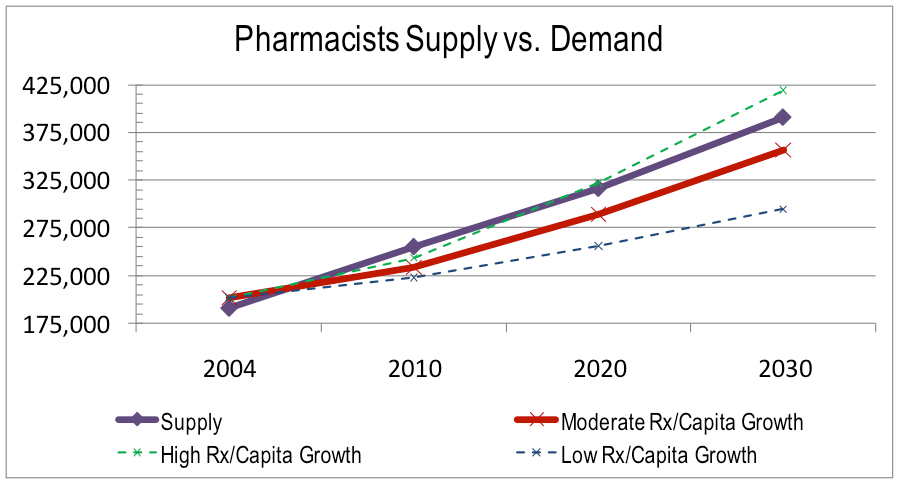Article
Pharmacist Supply and Demand: Past, Present, and Future
It was just a few years ago that jobs for recent pharmacy graduates offered 6 figures, a competitive signing bonus, and a choice of several work locations.
Katie Zavadski starts her article, “The Pharmacy School Bubble Is About to Burst,” by describing the good ol' days of pharmacy. It was just a few years ago that jobs for recent pharmacy graduates offered 6 figures, a competitive signing bonus (new cars were not uncommon), and a choice of several work locations. Recruitment events brought many job opportunities that were spread between just a few graduates; the demand was clearly greater than the supply.
As the "baby boomer" population continued to age and the role of the pharmacist on the health care team grew, universities responded by fervently adding new programs and expanding class sizes, often through distance-learning programs. The number of graduates has almost doubled since 2002, to approximately 13,000 today. Furthermore, an additional 17 pharmacy schools have been established over the past 4 years, meaning they have not yet had a graduating class.
States like California, Texas, New York, Ohio, Illinois, North Carolina, South Carolina, Georgia, and Pennsylvania have all seen significant increases in pharmacy graduates in recent years, but perhaps the best example is Tennessee. The state has gone from having 1 pharmacy school in 2006, located at the University of Tennessee at Memphis, to 6 today, with Lipscomb, Belmont, and Union University all graduating their first classes in spring 2012.
Unfortunately, as a direct result of the recession, those that had jobs were reluctant to give them up. The role of the pharmacist has continued to grow into caring for an aging population, but so have other health care professionals, such as nurse practitioners and physicians assistants. Subsequently, pay has remained stagnant (and, in many cases, lowered), the signing bonus is now the exception to the rule, and pharmacists must be willing to commute greater distances, often having to accept “floater" positions. Recruitment events still exist, but opportunities are fewer and spread between many more graduates; the supply has grown greater than the demand. The profession, Zavadski rightly says, is now “on the verge of a crisis.”
In a 2010 article, Daniel Brown, PharmD, dean of the Gregory School of Pharmacy at Palm Beach Atlantic University, recognized a shift from shortage to surplus: “Long-held assumptions about the rate of pharmacist job growth are beginning to crumble amid the uncertain health care and economic realities of our times, and yet, we, as an academy, continue to perpetrate a rate of unprecedented growth that has reached alarming proportions and shows no signs of abating.”
In her justification of a "pharmacy school bubble," Zavadski quotes Dr. Brown’s bold prediction of 20% unemployment of pharmacy grads by 2018, though without sharing the data behind it. And here is where my path diverges from Zavadski’s.
Examining the numbers, as the pharmacist job supply steadily grows, demand can take 1 of 3 paths:

Now for the good news: demand appears to be on the precipice of high growth. The role of the pharmacist is evolving towards more responsibility for patient care, and one can look toward flu season as a timely and relevant example.
A few years ago, patients would routinely visit the physician for flu shots. These days, the flu vaccine can be
—
and most often is
—
administered by pharmacists. The "baby boomer" population continues to age, and the Affordable Care Act is predicted to add millions more insured Americans who need care. As the recession wanes, those who were clinging to jobs for fear of retirement will be presumably less reluctant to retire. The pharmacy job market, like any other market, is cyclical, so it is only a matter of time for the market to correct itself—and that time looks to be coming soon.
Ashish Advani is a pharmacist and assistant professor, Mercer University College of Pharmacy, Atlanta, GA. He is also founder, InpharmD, and blogs at Stay InpharmD.






